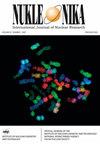克罗地亚萨格勒布市饮用水中137Cs和134Cs的长期调查
IF 0.3
4区 物理与天体物理
Q4 CHEMISTRY, INORGANIC & NUCLEAR
引用次数: 2
摘要
摘要:本文介绍了1987-2018年萨格勒布市饮用水中137Cs和134Cs活性浓度的长期调查结果。这两种放射性核素的最高活性浓度是在1987年测得的,此后呈指数下降,而134Cs在随后几年降至检测极限以下。2011年福岛第一核电站事故后,饮用水中再次检测到134Cs的存在。据估计,137Cs在饮用水中的环境停留时间为8.1年,在沉降物中的环境停留时间为5.7年。沉降物中的137Cs与饮用水中的137Cs具有很好的相关性,这表明沉降物是水污染的主要来源。观察到的切尔诺贝利后时期饮用水中134Cs/137Cs活度比与在其他环境样品中发现的比率相似。克罗地亚成年人因饮用水摄入放射性铯而获得的年有效剂量估计显示,1987年的剂量为0.28 μSv,到2018年减少到2.5 μSv,这表明饮用水不是放射性铯向人类转移的关键途径。本文章由计算机程序翻译,如有差异,请以英文原文为准。
Long-term investigation of 137Cs and 134Cs in drinking water in the city of Zagreb, Croatia
Abstract This paper presents the results of long-term investigations of 137Cs and 134Cs activity concentrations in drinking water in the city of Zagreb for the period 1987–2018. The highest activity concentrations of both radio-nuclides were measured in 1987, decreasing exponentially ever since, while 134Cs in several subsequent years fell under the detection limit. After the Fukushima Daiichi accident in 2011, the presence of 134Cs in drinking water was detected again. The environmental residence time for 137Cs was estimated to be 8.1 years in drinking water and 5.7 years in fallout. The correlation between 137Cs in fallout and in drinking water is very good, and this indicates that fallout is the main source of water contamination. The observed 134Cs/137Cs activity ratio in drinking water for the post-Chernobyl period was similar to the ratio found in other environmental samples. The estimation of annual effective doses received by the adult members of the Croatian population due to the intake of radiocaesium in drinking water showed quite small doses of 0.28 μSv in 1987 decreasing to 2.5 nSv in 2018, which indicated that drinking water was not a critical pathway for the transfer of radiocaesium to humans.
求助全文
通过发布文献求助,成功后即可免费获取论文全文。
去求助
来源期刊

Nukleonika
物理-无机化学与核化学
CiteScore
2.00
自引率
0.00%
发文量
5
审稿时长
4-8 weeks
期刊介绍:
"Nukleonika" is an international peer-reviewed, scientific journal publishing original top quality papers on fundamental, experimental, applied and theoretical aspects of nuclear sciences.
The fields of research include:
radiochemistry, radiation measurements, application of radionuclides in various branches of science and technology, chemistry of f-block elements, radiation chemistry, radiation physics, activation analysis, nuclear medicine, radiobiology, radiation safety, nuclear industrial electronics, environmental protection, radioactive wastes, nuclear technologies in material and process engineering, radioisotope diagnostic methods of engineering objects, nuclear physics, nuclear reactors and nuclear power, reactor physics, nuclear safety, fuel cycle, reactor calculations, nuclear chemical engineering, nuclear fusion, plasma physics etc.
 求助内容:
求助内容: 应助结果提醒方式:
应助结果提醒方式:


